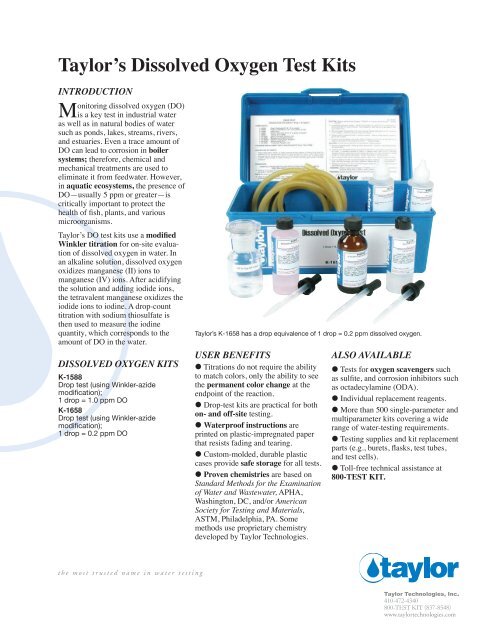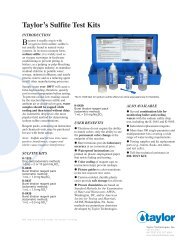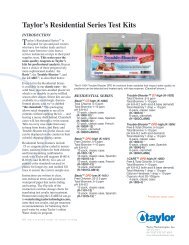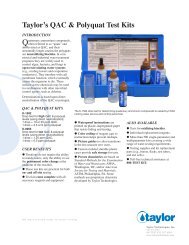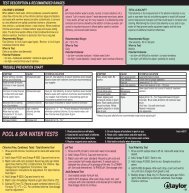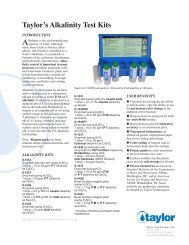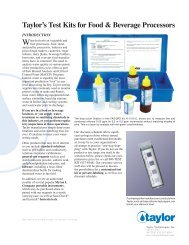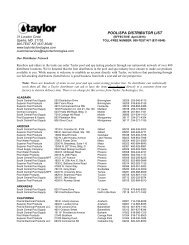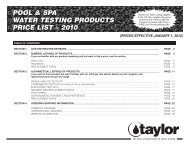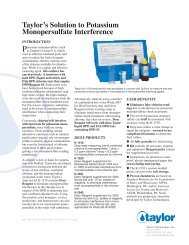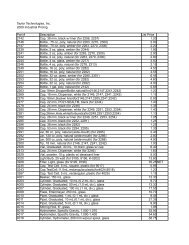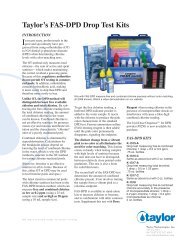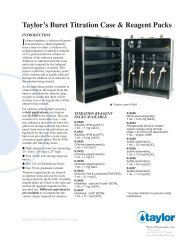Taylor's Dissolved Oxygen Test Kits - Taylor Technologies
Taylor's Dissolved Oxygen Test Kits - Taylor Technologies
Taylor's Dissolved Oxygen Test Kits - Taylor Technologies
- No tags were found...
You also want an ePaper? Increase the reach of your titles
YUMPU automatically turns print PDFs into web optimized ePapers that Google loves.
<strong>Taylor</strong>’s <strong>Dissolved</strong> <strong>Oxygen</strong> <strong>Test</strong> <strong>Kits</strong>INTRODUCTIONMonitoring dissolved oxygen (DO)is a key test in industrial wateras well as in natural bodies of watersuch as ponds, lakes, streams, rivers,and estuaries. Even a trace amount ofDO can lead to corrosion in boilersystems; therefore, chemical andmechanical treatments are used toeliminate it from feedwater. However,in aquatic ecosystems, the presence ofDO—usually 5 ppm or greater—iscritically important to protect thehealth of fish, plants, and variousmicroorganisms.<strong>Taylor</strong>’s DO test kits use a modifiedWinkler titration for on-site evaluationof dissolved oxygen in water. Inan alkaline solution, dissolved oxygenoxidizes manganese (II) ions tomanganese (IV) ions. After acidifyingthe solution and adding iodide ions,the tetravalent manganese oxidizes theiodide ions to iodine. A drop-counttitration with sodium thiosulfate isthen used to measure the iodinequantity, which corresponds to theamount of DO in the water.DISSOLVED OXYGEN KITSK-1588Drop test (using Winkler-azidemodification);1 drop = 1.0 ppm DOK-1658Drop test (using Winkler-azidemodification);1 drop = 0.2 ppm DO<strong>Taylor</strong>’s K-1658 has a drop equivalence of 1 drop = 0.2 ppm dissolved oxygen.USER BENEFITS•Titrations do not require the abilityto match colors, only the ability to seethe permanent color change at the•endpoint of the reaction.Drop-test kits are practical for both•on- and off-site testing.Waterproof instructions areprinted on plastic-impregnated paper•that resists fading and tearing.Custom-molded, durable plastic•cases provide safe storage for all tests.Proven chemistries are based onStandard Methods for the Examinationof Water and Wastewater, APHA,Washington, DC, and/or AmericanSociety for <strong>Test</strong>ing and Materials,ASTM, Philadelphia, PA. Somemethods use proprietary chemistrydeveloped by <strong>Taylor</strong> <strong>Technologies</strong>.ALSO AVAILABLE•<strong>Test</strong>s for oxygen scavengers suchas sulfite, and corrosion inhibitors suchas octadecylamine (ODA).•Individual replacement reagents.More than 500 single-parameter andmultiparameter kits covering a widerange of water-testing requirements.•<strong>Test</strong>ing supplies and kit replacementparts (e.g., burets, flasks, test tubes,and test cells).•Toll-free technical assistance at800-TEST KIT.
REPRESENTATIVE TEST PROCEDUREReproduced from K-1658 instruction:DROP TESTDISSOLVED OXYGEN (1 drop = 0.2 ppm)COMPONENTS:1 x 4029 Pipet, Calibrated 0.5 & 1.0 mL, plastic2 x 4030 Pipets, Calibrated 0.5 & 1.0 mL, plastic w/cap1 x 5069 Instruction1 x 9269 Bottle, Calibrated 50 mL 2 oz, glass w/stopper1 x 9291 Tubing, 6 ft, rubber1 x R-0636 Starch Indicator Solution, DB1 x R-0658 Manganous Sulfate Solution1 x R-0660S Alkaline Iodide Azide Reagent*1 x R-0729 Sulfuric Acid 50%**1 x R-0780 Thiosulfate Reagent, DBTO ORDER REPLACEMENT PARTS AND REAGENTS CALL TOLL-FREE 800-TEST KIT(800-837-8548).COLLECTION OF SAMPLE:Use a clean glass, plastic, or metal container whose capacity is three to five times the volumeof 50 mL sample bottle (#9269) to collect sample from faucet. Insert rubber tubing into openfaucet. Allow sample bottle to overflow at least once per minute. If sample water is warm,pass through a copper cooling coil. Perform test with glass bottle in outside container.PROCEDURE:CAREFULLY READ AND FOLLOW PRECAUTIONS ON REAGENT LABELS.KEEP REAGENTS AWAY FROM CHILDREN.1. Using a 1.0 mL pipet (#4030), add 1 dropperful (as much as can be drawn up by meansof the bulb) R-0658 Manganous Sulfate Solution to 50 mL bottle (#9269).NOTE: Be certain a drop of R-0658 Manganous Sulfate Solution is hanging from tip of pipet.2. Using a separate 1.0 mL pipet, add 1 dropperful (as much as can be drawn up by meansInstr. #5069CAUTION: Alkaline Iodide Azide Reagent (R-0660S) is a strong caustic solution. Handlecarefully.3. Immediately wet glass stopper. Gently drop straight into neck of 50 mL bottle withoutremoving bottle from outer container. Allow stopper to “seat” itself by its own weight, thenpress down firmly.4. Remove sealed sample bottle from outer container. Rotate bottle gently to mix. Examinefor air bubbles. If present, discard sample and repeat.5. Replace tightly stoppered bottle in outside container. Allow to stand several minutes topermit floc to settle.6. Carefully remove stopper under water. Add 1 dropperful (as much as can be drawn up bymeans of the bulb) R-0729 Sulfuric Acid 50%**. Replace stopper.CAUTION: R-0729 Sulfuric Acid 50% is a strong acid. Handle carefully.7. Remove stoppered bottle. Rotate gently to dissolve floc. Sample is now fixed and readyfor drop titration.8. Carefully pour off treated sample until bottom of meniscus (curved portion) is exactly at50 mL mark. If colorless—proceed to Step 9. If yellow (brown) add R-0780 ThiosulfateReagent dropwise, swirling and counting after each drop, until color changes from yellow(brown) to straw-colored (pale yellow). Always hold bottle in vertical position.9. Add 10 drops R-0636 Starch Indicator Solution. Swirl to mix. Sample should turn blue.10. Continue adding R-0780 Thiosulfate Reagent dropwise, swirling and counting after eachdrop, until color changes from blue to colorless. Always hold bottle in vertical position.11. Multiply total drops of R-0780 Thiosulfate Reagent (Steps 8 & 10) by 0.2. Record as partsper million (ppm) dissolved oxygen.*WARNING: Alkaline Iodide Azide Reagent (R-0660S) contains 50% sodium hydroxide, acorrosive alkali, and 1% sodium azide, a poison.**WARNING: Sulfuric Acid 50% (R-0729) contains 62% sulfuric acid (w/w), a corrosive acid.of the bulb) R-0660S Alkaline Iodide Azide Reagent*. 31 Loveton Circle, Sparks, MD 21152 U.S.A.800-TEST KIT (837-8548) • 410-472-4340 2/90rev. 111210


